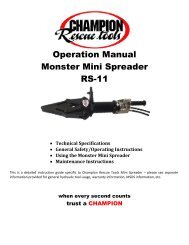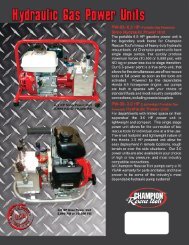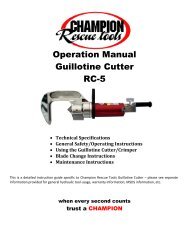Using the SUPER BEAST as a Spreader - Champion Rescue Tools
Using the SUPER BEAST as a Spreader - Champion Rescue Tools
Using the SUPER BEAST as a Spreader - Champion Rescue Tools
You also want an ePaper? Increase the reach of your titles
YUMPU automatically turns print PDFs into web optimized ePapers that Google loves.
<strong>Champion</strong> <strong>Rescue</strong> <strong>Tools</strong> – <strong>SUPER</strong> <strong>BEAST</strong> Multi-tool Detailed Tool Instructions<br />
<strong>Using</strong> <strong>the</strong> <strong>SUPER</strong> <strong>BEAST</strong> <strong>as</strong> a Cutter<br />
1. Always inspect <strong>the</strong> tool prior to each use.<br />
2. Turn <strong>the</strong> valve at <strong>the</strong> power unit to <strong>the</strong> “ON”<br />
position<br />
3. Be sure to follow proper general procedures (<strong>as</strong> well<br />
<strong>as</strong> any department specific procedures) for<br />
performing vehicle extrication – o<strong>the</strong>rwise severe<br />
injure or even death for occupants or tool operators<br />
is possible.<br />
4. Do a visual check before making a cut, <strong>as</strong> for every<br />
action <strong>the</strong>re is often an equal reactions. Check<br />
twice and cut once.<br />
5. Open <strong>the</strong> cutting blade to <strong>the</strong> distance required to<br />
ensure you get <strong>the</strong> material to be cut into <strong>the</strong> notch<br />
(bottom of <strong>the</strong> blades close to <strong>the</strong> blade bolt) and<br />
<strong>Using</strong> <strong>the</strong> <strong>SUPER</strong> <strong>BEAST</strong> <strong>as</strong> a <strong>Spreader</strong><br />
1. The <strong>SUPER</strong> <strong>BEAST</strong> <strong>Spreader</strong> can be used to spread,<br />
crush or lift. Keep in mind if you lift with this tool,<br />
lift 1” crib 1”.<br />
2. DO NOT use <strong>the</strong> aluminum portion of <strong>the</strong> arms for<br />
spreading, lifting, or crushing <strong>as</strong> this may result in<br />
damage to <strong>the</strong> arms and presents potential risk to<br />
<strong>the</strong> operator.<br />
3. Try and use <strong>as</strong> much spreading surface area to push,<br />
crush, or lift on <strong>the</strong> tips so you have more contact<br />
surface.<br />
4. Always pick up <strong>the</strong> tool by <strong>the</strong> handles only.<br />
Maintenance Instructions<br />
1. Inspect both heads and <strong>the</strong> tool after every use for<br />
wear and damage. Never use a damaged tool.<br />
2. Remove any debris from <strong>the</strong> tool or heads.<br />
3. Keep <strong>the</strong> tool clean and dry. Wipe with a clean<br />
cloth if necessary. Use a mild detergent to clean <strong>the</strong><br />
tool and dry thoroughly.<br />
4. Lubricate <strong>the</strong> valve spring with a light lubricant, such<br />
<strong>as</strong> WD-40.<br />
5. Lubricate <strong>the</strong> detents on <strong>the</strong> pins with a light<br />
lubricant such <strong>as</strong> WD-40 or a light silicon lubricant.<br />
Check adjustments on detents.<br />
6. Ensure that all handles are tight. There are screws<br />
on both rear and front handles, use blue lock-tight<br />
to secure if necessary.<br />
© <strong>Champion</strong> <strong>Rescue</strong> <strong>Tools</strong><br />
start your cut. If you are unable to get <strong>the</strong> material<br />
all <strong>the</strong> way into <strong>the</strong> notch at le<strong>as</strong>t get it <strong>as</strong> deep <strong>as</strong><br />
possible. Don’t use <strong>the</strong> tip of <strong>the</strong> blades on solid or<br />
extremely had materials. If <strong>the</strong> cut cannot be made<br />
<strong>the</strong> first time, <strong>the</strong>n reopen <strong>the</strong> blades and<br />
reposition for ano<strong>the</strong>r cut. Always use common<br />
sense.<br />
6. Remember, <strong>the</strong> notch is where <strong>the</strong> tool makes its<br />
maximum power.<br />
<strong>Champion</strong> offers a line of specialty blades designed<br />
for specific extrication applications – contact <strong>the</strong><br />
Sales Department for more information.<br />
5. To take <strong>the</strong> spreader off line or to change <strong>the</strong> head<br />
back to <strong>the</strong> cutter head follow <strong>the</strong> head change<br />
instructions provided in this manual.<br />
6. When <strong>the</strong> tool is not in action rest <strong>the</strong> tool on a part<br />
of <strong>the</strong> vehicle or structure with a firm grip on <strong>the</strong><br />
handles while you are awaiting you next t<strong>as</strong>k.<br />
O<strong>the</strong>rwise you can rest <strong>the</strong> tip of <strong>the</strong> tool on <strong>the</strong><br />
ground, in vertical position, holding <strong>the</strong> rear handle<br />
while you are waiting. This will help reduce<br />
operator fatigue.<br />
7. Inspect couplers to ensure that <strong>the</strong>y operated<br />
correctly and are free of dirt and debris. Blow out<br />
with an air hose if needed.<br />
8. Inspect hoses for cracks, cuts and bulges. DO NOT<br />
operate tools with damaged hoses.<br />
9. Inspect <strong>the</strong> spreader arms and cutting head for<br />
wear or damage. DO NOT operate with damaged<br />
arms or blades.<br />
10. Keep tool free from rust and corrosion.<br />
11. Replace handle if broken or damaged.<br />
12. Replace Missing or damaged decals, if needed.







